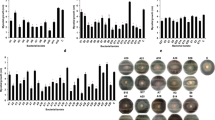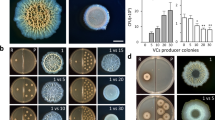Abstract
Bacterial antagonists are bacteria that negatively affect the growth of other organisms. Many antagonists inhibit the growth of fungi by various mechanisms, e.g., secretion of lytic enzymes, siderophores and antibiotics. Such inhibition of fungal growth may indirectly support plant growth. Here, we demonstrate that small organic volatile compounds (VOCs) emitted from bacterial antagonists negatively influence the mycelial growth of the soil-borne phytopathogenic fungus Rhizoctonia solani Kühn. Strong inhibitions (99–80%) under the test conditions were observed with Stenotrophomonas maltophilia R3089, Serratia plymuthica HRO-C48, Stenotrophomonas rhizophila P69, Serratia odorifera 4Rx13, Pseudomonas trivialis 3Re2-7, S. plymuthica 3Re4-18 and Bacillus subtilis B2g. Pseudomonas fluorescens L13-6-12 and Burkholderia cepacia 1S18 achieved 30% growth reduction. The VOC profiles of these antagonists, obtained through headspace collection and analysis on GC-MS, show different compositions and complexities ranging from 1 to almost 30 compounds. Most volatiles are species-specific, but overlapping volatile patterns were found for Serratia spp. and Pseudomonas spp. Many of the bacterial VOCs could not be identified for lack of match with mass-spectra of volatiles in the databases.



Similar content being viewed by others
References
Akiyama K, Matsuzaki K, Hayashi H (2005) Plant sesquiterpenes induce hyphal branching in arbuscular mycorrhizal fungi. Nature 435:824–827
Alstrom S (2001) Characteristics of bacteria from oil seed rape in relation to their biocontrol of activity against Verticillium dahliae. J Phytopathol 149:57–64
Anderson NA (1982) The genetics and pathology of Rhizoctonia solani. Annu Rev Phytopathol 20:329–374
Arimura G, Ozawa R, Kugimiya S, Takabayashi J, Bohlmann J (2004) Herbivore-induced defense response in a model legume. Two-spotted spider mites induce emission of (E)-β-ocimene and transcript accumulation of (E)-β-ocimene synthase in Lotus japonicus. Plant Physiol 135:1976–1983
Aström B, Gerhardson B (1988) Differential reactions of wheat and pea genotypes to root inoculations with growth-affecting rhizobacteria. Plant Soil 109:263–269
Bais HP, Park SW, Weir TL, Callaway RM, Vivanco JM (2004) How plants communicate using the underground information superhighway. Trends Plant Sci 9:26–32
Bais HP, Weir TL, Perry GR, Gilroy S, Vivanco JM (2006) The role of root exudates in rhizosphere interactions with plants and other organisms. Annu Rev Plant Biol 57:233–266
Berg G, Ballin G (1994) Bacterial antagonists to Verticillium dahliae. J Phytopathol 141:99–110
Berg G, Roskot N, Steidle A, Eberl L, Zock A, Smalla K (2002) Plant-dependent genotypic and phenotypic diversity of antagonistic rhizobacteria isolated from different Verticillium host plants. Appl Environ Microbiol 68:3328–3338
Berg G, Krechel A, Ditz M, Faupel A, Ulrich A, Hallmann J (2005) Comparison of endophytic and ectophytic potato-associated bacterial communities and their antagonistic activity against plant pathogenic fungi. FEMS Microbiol Ecol 51:215–229
Bloemberg GV, Lugtenberg BJJ (2001) Molecular basis of plant growth promotion and biocontrol by rhizobacteria. Curr Opin Plant Biol 4:343–350
Borg-Karlson AK, Englund FO, Unelius CR (1994) Dimethyl oligosulphide, major volatile released from Sauromatum guttatum and Phallus impudicus. Phytochemistry 35:2:889–892
Bouwmeester HJ, Matusova R, Sun ZK, Beale MH (2003) Secondary metabolite signalling in host-parasitic plant interactions. Curr Opin Plant Biol 6:358–364
Cane DE, Watt RM (2003) Expression and mechanistic analysis of a germacradienol synthase from Streptomyces coelicolor implicated in geosmin biosynthesis. Proc Natl Acad Sci USA 100:1547–1551
Chaurasia B, Pandey A, Palni LMS, Trivedi P, Kumar B, Colvin N (2005) Diffusible and volatile compounds produced by an antagonistic Bacillus subtilis strain cause structural deformations in pathogenic fungi in vitro. Microbiol Res 160:75–81
Chen F, Ro DK, Petri J, Gershenzon J, Bohlmann J, Pichersky E, Tholl D (2004) Characterization of a root-specific Arabidopsis terpene synthase responsible for the formation of the volatile monterpene 1,8-cineole. Plant Physiol 135:1956–1966
Cook RJ, Tomashow LS, Weller DM, Fujimoto D, Mazzola M, Bangera G, Kim DS (1995) Molecular mechanisms of defense by rhizobacteria against root disease. Proc Natl Acad Sci USA 92:4197–4201
Dainty RH, Edwards RA, Hibbard CM, Marnewick JJ (1989) Volatile compounds associated with microbial growth on normal and high pH beef stored at chill temperature. J Appl Bacteriol 66:281–289
Denton M, Kerr KG (1998) Microbiological and clinical aspects of infections associated with Stenotrophomonas maltophilia. Clin Microbiol Rev 1:7–80
Dickschat JS, Martens R, Brinkhoff T, Simon M, Schulz S (2005) Volatiles released by a Streptomyces species isolated from the North Sea. Chem Biodivers 2:837–865
Etschmann MMW, Bluemke W, Sell D, Schrader J (2002) Biotechnological production of 2-phenylethanol. Appl Microbiol Biotechnol 59:1–8
Faltin F, Lottmann J, Grosch R, Berg G (2004) Strategy to select and assess antagonistic bacteria for biological control of Rhizoctonia solani Kühn. Can J Microbiol 50:811–820
Fernando WGD, Ramarathnam R, Krishnamoorthy AS, Savchuk SC (2005) Identification and use of potential bacterial organic antifungal volatiles. Biocontrol 37:955–964
Fiddaman PJ, Rossall S (1994) Effect of substrate on the production of antifungal volatiles from Bacillus subtilis. J Appl Bacteriol 76:395–405
Gershenzon J, Kreis W (1999) Biochemistry of terpenoids: monoterpenes, sespuiterpenes, diterpenes, sterols, cardiac glycosides and steroid saponins. In: Wink M (ed) Biochemistry of plant secondary metabolism, annual plant reviews. Academic, Sheffield, pp 222–280
Grosch R, Faltin F, Lottmann J, Kofoet A, Berg G (2005) Effectiveness of three antagonistic bacterial isolates to suppress Rhizoctonia solani Kühn on lettuce and potato. Can J Microbiol 51:345–353
Gupta AM, Gopal KVB, Tilak R (2000) Mechanism of plant growth promotion by rhizobacteria. Ind J Exp Biol 38:856–862
Gust B, Challis GL, Fowler K, Kieser T, Chater KF (2003) PCR-targeted Streptomyces gene replacement identifies a protein domain needed for biosynthesis of the sesquiterpene soil odor geosmin. Proc Natl Acad Sci USA 100:1541–1546
Haas D, Defago G (2005) Biological control of soil-borne pathogens by fluorescent pseudomonads. Nat Rev Microbiol 10:1–13
Handelsman J, Stabb EV (1996) Biocontrol of soilborne plant pathogens. Plant Cell 8:1855–1869
Ingram LO, Buttke TM (1984) Effects of alcohols on microorganisms. Adv Microb Physiol 25:253–300
Jakobi M, Winkelmann G, Kaiser D, Kempter C, Jung G, Berg G, Bahl H (1996) Maltophilin: a new antifungal compound produced by Stenotrophomonas maltophilia R3089. J Antibiot 49:1101–1104
Kalbe C, Marten P, Berg G (1996) Members of the genus Serratia as beneficial rhizobacteria of oilseed rape. Microbiol Res 151:4433–4400
Krechel A, Faupel A, Hallmann J, Ulrich A, Berg G (2002) Potato-associated bacteria and their antagonistic potential towards plant pathogenic fungi and the plant parasitic nematode Meloidogyne incognita (Kofoid & White) Chitwood. Can J Microbiol 48:772–786
Kurze S, Bahl H, Dahl R, Berg G (2001) Biological control of fungal strawberry diseases by Serratia plymuthica HRO-C48. Plant Dis 85:529–534
Lottmann J, Berg G (2001) Phenotypic and genotypic characterization of antagonistic bacteria associated with roots of transgenic and nontransgenic potato plants. Microbiol Res 156:75–82
Lucchini JJ, Bonnaveiro N, Cremieux A, le Goffic F (1993) Mechanism of bactericidal action of phenylethyl alcohol in Escherichia coli. Curr Microbiol 27:295–300
Marten P, Smalla K, Berg G (2000) Genotypic and phenotypic differentiation of antifungal biocontrol strains belonging to Bacillus subtilis. J Appl Microbiol 89:463–473
Minkwitz A, Berg G (2001) Comparison of antifungal activities and 16S ribosomal DNA sequences of clinical and environmental isolates of Stenotrophomonas maltophilia. J Clin Microbiol 39:139–145
Opelt K, Berg G (2004) Diversity and antagonistic potential of bacteria associated with byrophytes from nutrient poor habitats of the Baltic Sea Coast. Appl Environ Microbiol 70:6569–6579
Pare PW, Tumlinson JH (1999) Plant volatiles as a defense against insect herbivores. Plant Physiol 121:325–331
Piechulla B, Pott MB (2003) Plant scents—mediator of inter- and intraorganismic communication. Planta 217:687–689
Raaijmakers JM, Vlami M, de Souza JT (2002) Antibiotic production by bacterial biocontrol agents. Antonie Van Leeuwenhoek 81:537–47
Rasmann S, Köllner TG, Degenhardt J, Hiltpold I, Toepfer S, Kuhlmann U, Gershenzon J (2005) Recruitment of entomophathogenic nematodes by insect-damaged maize roots. Nature 434:732–737
Ryu CM, Farag MA, Hu CH, Reddy MS, Wie HX, Pare PW, Kloepper JW (2003) Bacterial volatiles promote growth in Arabidopsis. PNAS 100:4927–4932
Ryu CM, Farag MA, Hu CH, Reddy MS, Kloepper JW, Pare PW (2004) Bacterial volatiles induce systemic resistance in Arabidopsis. Plant Physiol 134:1017–1026
Schöller CEG, Gürtler H, Petersen R, Molin S, Wilkins K (2002) Volatile metabolites from Actinomycetes. J Agric Food Chem 50:2615–2621
Sneh B, Jabaji-Hare S, Neate SM, Dijst G (1996) Rhizoctonia species: taxonomy, molecular biology, ecology; pathology and disease control. Kluwer, Dordrecht
Steeghs M, Bais HP, Gouwe JD, Goldan P, Kuster W, Northway M, Fall R, Vivanco JM (2004) Proton-transfer-reaction mass spectrometry as a new tool for real time analysis of root-secreted volatile organic compounds in Arabidopsis. Plant Physiol 135:47–58
Stotzky G, Schenk S (1976) Volatile organic compounds and microorganisms. CRC Crit Rev Microbiol 4:333–382
Walker TS, Bais HP, Grotewold E, Vivanco MJ (2003) Update on root exudation and rhizosphere biology. Plant Physiol 132:44–51
Weller DM, Raaijmakers JM, Gardener BB, Tomashow LS (2002) Microbial populations responsible for specific soil suppressiveness to plant pathogens. Annu Rev Phytopathol 40:309–48
Wheatley RE (2002) The consequences of volatile organic compound mediated bacterial and fungal interactions. Antonie Van Leeuwenhoek 81:357–364
Whipps JM (2001) Microbial interaction and biocontrol in the rhizosphere. J Exp Bot 52:487–511
Wolf A, Fritze A, Hagemann M, Berg G (2002) Stenotrophomonas rhizophila sp. Nov., a novel plant associated bacterium with antifungal properties. Int J Syst Evol Microbiol 52:1937–1944
Zhang YQ, Ren SX, Li HL, Wang YX, Fu G, Yang J, Qin ZQ, Miao YG, Wang WY, Chen RS, Shen Y, Chen Z, Yuan ZH, Zhao GP, Qu D, Danchin A, Wen YM (2003) Genome-based analysis of virulence genes in a non-biofilm-forming Staphylococcus epidermidis strain (ATCC 12228). Mol Microbiol 49:1577–1593
Acknowledgment
The authors thank Hella Goschke (University of Rostock) for cultivating the antagonists and R. solani, Prof. Dr. W. Francke (University of Hamburg) for structural investigations of the Serratia odorifera VOC, and Prof. Dr. E. Pichersky (University of Ann Arbor, Michigan, USA) for critical reading the manuscript.
Author information
Authors and Affiliations
Corresponding author
Rights and permissions
About this article
Cite this article
Kai, M., Effmert, U., Berg, G. et al. Volatiles of bacterial antagonists inhibit mycelial growth of the plant pathogen Rhizoctonia solani . Arch Microbiol 187, 351–360 (2007). https://doi.org/10.1007/s00203-006-0199-0
Received:
Revised:
Accepted:
Published:
Issue Date:
DOI: https://doi.org/10.1007/s00203-006-0199-0




